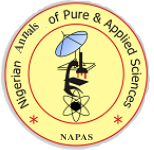Rainwater Quality as a Function of Time of Harvest
DOI:
Keywords:
Rainwater quality,, Physicochemical analysis,, Microbiological parameters, , Heavy metals,, MakurdiAbstract
Rainwater samples were collected at five minute intervals up to 25 minutes and assessed for physicochemical, total coliform load and some heavy metals. This was aimed at evaluating the purity of the rainwater through the progress of the rain duration. The result of temperature for the three months was found to range from 21.9 - 23.4 25oC, pH was found to range between 6.0-6.20, turbidity was observed to range between 0.67-2.11NTU. Conductivity was observed to range from 2-7 µs/cm, total hardness was constant be 20 mg/L, while total dissolved solids was found to be between 1 to 2 mg/L. Total suspended solids range between 36 to 62 mg/L. The mean values of BOD and COD were found to range between 0.1- 0.80 mg/L and 0.4-1.6 mg/L respectively. Chloride and sulphates were found to range between 102 mg/L to 112 mg/L and 7 to 9 mg/L respectively. Phosphates and nitrates were found to range between 0.13mg/L to 0.60 mg/L and 2.0 mg/L to 3.0mg/L respectively. Result of total coliform count was negative in all samples. Varying concentrations of heavy metals was observed; Zn (0.159 - 0.30) mg/L, Cadmium, lead, aluminum and iron were found to range between 0.009-0.11mg/L, 0.001 - 0.002 mg/L, 0.006-0.016 mg/L and 0.154-0.224 mg/L respectively. Nickel and chromium were not detected. The concentrations of heavy metals were observed to be very low compared to WHO permissible limits and Nigerian National Agency for Food and Drug Administration and Control. All parameters analyzed were observed to decrease as the time of the rainfall increases.
References
Abdullah Aksu (2015). Sources of metal pollution in the urban atmosphere (A case study: Tuzla Journal of Environmental Health Science & Engineering (2015) 13:79 DOI 10.1186/s40201-015-0224-9
Adhena A.W., Belay Z.M., Angaw K.A, and Jemal Y.D. (2015). Physicochemical Analysis of Drinking Water Quality at Jigjiga City, Ethiopia. Americal Journal of Environmental Protection. 4(1):29-32
Adriano T.E., Antonio E.M, and Rodolfo G.N. (2011). Rainwater Harvesting, Quality Assessment, and Utilization in Region 1. E-International Scientific Research Journal. 3(2):145-155.
Amin, M.T., and A.A. Alazba (2011). Probable Sources of Rainwater Contamination IzA Rainwater Harvesting System and Remedial Options, Australian Journal of Basic and Applied Sciences, 5(12): 1054-1064
Cheesbrough M. (2006). District Laboratory Practice in Tropical Countries. 2nd Ed. Cambridge University Press. Published in the United State of America by Cambridge. New York.
Chubaka CE, Whiley H, Edwards JW, Ross KE. Lead, Zinc, Copper, and Cadmium Content of Water from South Australian Rainwater Tanks. International Journal of Environmental Research and Public Health. 2018; 15(7):1551. https://doi.org/10.3390/ijerph15071551
Chukwuma C.G., Ogbu K.N, and Okonkwo I.F. (2013). Quality Assessment of Direct Harvested Rainwater in Parts of Anambra State. Nigeria. International Journal of Agriculture and Biosciences. 2(3):120-123.
Dimowo B.O. (2013). Assessment of some Physico-chemical Parameters of River Ogun (Abeokuta, Ogun State, Southern Nigeria) in Comparison with National and International Standards. International Journal of Aquaculture. 3(15):79-84.
Emerole C.O., Emekaraola M, and Emerole C.G. (2015). Quality of Harvested Rainwater in Oweri, Imo State. Nigeria. International Journal of Multidisciplinary and Current Research. 3(5):1162-1166.
Ftsum G., Abraha G., Amanuel H, and Samuael E. (2015). Investigations of Physioco-chemical Parameters and its Pollution Implications of Elala River, Mekelle Tigray, Ethiopia. Momona Ethiopian Journal of Sciences. 7(2):240-257.
Ikhioya P.E; Osu Charles I.; Obuzor, G.U.(2015). Physiochemical characteristic of Harvested Rainwater from Bodo Community in Rivers State, Nigeria, Journal Applied Science. Environmental Management.Dec. 2015 Vol. 19 (4) 671 677
Ipav S.O., Dafosunjo k, and Asaar G.B (2012). Quality Assessment of Rainwater Around a Cement Factory in Benue State, Nigeria. Mediterranean Journal of Social Sciences.3(14):134-142.
Jamal A.M. (2012). Determination of Iron, Copper, Lead, and Cadmium concentrations in Rainwater Tanks in Misurata, Libya. APRN Journal of Science and Technology. 2(8):676-680.
Lodh R., Paul R., Karmakar B, and Das M.K. (2014). Physicochemical Studies of Water Quality with Special Reference to Ancient Lakes of Udaipur City, Tripura India. International Journal of Scientific and Research Publications. 4(6):1-9.
Mustafa A.I., Ibrahim A.A., Haruna Y.I and Abubakar S. (2013). Physicochemical and Bacteriological Analysis of Drinking Water from wash Boreholes in Maiduguri Metropolis, Borno State. Nigeria. African Journal of Food Science. 7(1):9-13.
Ochori M.T. and Aholo O. (2012). Seasonal Variation in Physioco-chemical Parameters of Rural Groundwater of Benue State, Nigeria. Journal of Asian Scientific Research. 2(10):574-586. 14.
Olaoye R.A., Akinwale C.O., Sridhar M.K, and Adewole E.M. (2013). Examining the Effectiveness of Rainwater Collection Systems in a Nigerian Leper Colony using Behavioural Mode. ARPN Journal of Engineering and Applied Sciences. 8(1): 319-323.
Olaruntade A.J and Oguntunde P.G (2009). Effective Water Resource Management as a
Panacea for Climatic Change Problem in Nigeria.Journal of Engineering and Earth Science. 3(2): 18-25.
Olowoye D.N. (2011). Physiochemical Characteristics of Rainwater Quality of Warri Axis of Delta State in the Western Nigeria Delta Region of Nigeria. Journal of Environmental Chemistry and Ecotoxicology. 3(12): 320-322.
Olumuyiwa I.O., Fred A.O, and George M.O. (2012). Groundwater: Characteristics, Qualities Pollutants, and Treatments: An Overview. International Journal of Water Resources and Environmental Engineering. 4(6):162-170.
Omolare L. and Oloke D. (2015). Rainwater Harvesting in Ibadan City Nigeria: Socio-economic Survey and Common water Supply Practices. American Journal of Water Resources. 3(3):61-72
Pawar-Patil V.S and Sagar P.M. (2013). Potential Roof Rainwater Harvesting in Pirwadi Village of Kolhapur District, Maharashtra (India). A Geospatal Approach. Journal of Research in Humanities and Social Sciences. 1(4): 19-24.
Prasad M., Muralidhara B.R., Ramakrishna M.R, and Sunitha V. (2014). Studies of Physicochemical Parameters to Assess the Water Quality in Obula Varipalli Mandal of YRS (Kadapa) District, Andhra Pradesh, India. International Journal of Current Research and Academic Review. 2(12):31-41.
Ravindra K. and Arvind K.J. (2015). Studies on Physico-chemical and Biological Parameters of Kamla River Water. International Journal of Advanced Research. 3(10):88-93.
Reeta B. (2012). Comparative Analysis of Physico-chemical Parameters of Hasdeo River Barrage and Arpa River Water Samples of Bilaspur Region. International Journal of Scientific Research Publications. 2(9):15.
Sadia Rahman, M. T. R. Khan, Shatirah Akib,Nazli Bin Che Din, S. K. Biswas, and S. M. Shirazi (2014). Sustainability of Rainwater Harvesting System in terms of Water Quality, Sustainability of Rainwater Harvesting System in terms of Water Quality The Scientific World Journal Volume 2014, 1-10 http://dx.doi.org/10.1155/2014/721357
Samuel J.C., Abudu B.D., Reginald Q., Samuel O, and Noel B. (2015). Comparative Assessment of Heavy Metals in Drinking-water Sources in two small-scale Mining Communities in Northern Ghana. International Journal of Environmental Research and Public Health. 6(12):10620-10634.
Vaishnavi M.V and Shelly Gupta. (2015). Study of Level of Heavy Metals in the River Waters of Regions in and Around Pune City, Maharashtra, India. International Journal of Ecology and Ecosolution. 2(3):36-40.
Vilane B.R.T and Mtshali C.S. (2015). Assessment of Quality of Rooftop Rainwater Harvested at Nwanbeni, Swaziland. Direct Research Journal of Agriculture and Food Science (DRJAFS). 3(1):17-25.
WHO (2011). Guidelines for Drinking-water Quality. 4th Ed. Geneva 27, Switzerland.
Downloads
Published
How to Cite
Issue
Section
License
Copyright (c) 2022 BA Anhwange, NL Magashi

This work is licensed under a Creative Commons Attribution-ShareAlike 4.0 International License.



 Contact Us
Contact Us Editorial Team
Editorial Team Join As A Reviewer
Join As A Reviewer  Request For Print Copy
Request For Print Copy


 Cprint Publishers
Cprint Publishers